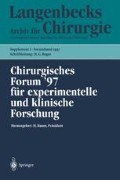Zusammenfassung
Derzeit sind zur Erfassung der Transplantatfunktion nach Dünndarmtransplantation (SBTX) keine Plasmaparameter etabliert. Dieser Umstand erfordert ein geübtes klinisches Management sowie wiederholte endoskopische Untersuchungen des Dünndarmes mit Entnahme von Mukosabiopsien zur Kontrolle der Transplantatfunktion. Vorangegangene experimentelle Untersuchungen belegten, daß die extrazelluläre Matrix (ECM) sensitiv und frühzeitig, bereits vor Reperfusion, mit der Schwere des Konservierungs- und Reperfusionsschadens korrelierende Veränderungen zeigte [1, 2]. Laminin ist einer der wichtigsten Bestandteile der subendothelialen und epithelialen Basalmembran (Lamina propria). Laminin ist ein biologisch aktives Glykoprotein, daß nachweislich eine bedeutende Rolle in der Regulierung der Zell-Zell-Interaktion, der Zell-Adhäsion, -Migration und Differenzierung von Endothelzellen spielt [3, 4]. Hyaluronsäure fand sich immunhistochemisch vorwiegend im lockeren Bindegewebe nahe der Lamina propria und der endothelzelligen Basalmembran [5]. Beide ECM-Parameter, Laminin und Hyaluronsäure, werden innerhalb weniger Stunden nach Stimulation durch inflammatorische Mediatoren und Zytokinen vermehrt produziert [3, 4, 6]. Es ist daher denkbar, daß Veränderungen der ECM-Parameter, Laminin und Hyaluronsäure, nicht nur im Gewebe, sondern auch im Plasma nach Reperfusion sowie in der frühen Phase der akuten Abstoßung zu finden sind.
Diese Arbeit wurde durch die Deutsche Forschungsgemeinschaft (Mu 905/2–1) unterstützt.
Access this chapter
Tax calculation will be finalised at checkout
Purchases are for personal use only
Preview
Unable to display preview. Download preview PDF.
Literatur
Mueller AR, Nalesnik M, Langrehr JM, Rao PN, Hoffman RA, Schraut WH (1993) Small bowel preservation causes primarily basement membrane and endothelial rather than epithelial cell injury. Transplantation 56: 1499–1504
Mueller AR, Rao PN, Snyder JT, Hoffman RA, Schraut WH (1993) Evaluation of hyaluronic acid and purine nucleoside phosphorylase in vascular and luminal effluents of small bowel grafts as parameters of preservation injury. Transplantation 55: 1225–1229
Martin GR (1987) Laminin and other basement membrane components. Annu Rev Cell Biol 3: 57–84
Abrahamson DR, Caulfield JP (1985) Distribution of laminin within rat and mouse renal, splenic, intestinal and hepatic basement membrane identified after intravenous injection of heterologous antilaminin IgG. Lab Invest 52: 169–180
Gerdin B, Hällgren R (1991) Localisation of hyaluronan in the human intestinal wall. Gut 2: 760–762
Laurent TC, Fraser JRE (1992) Hyaluronan. FASEB 6: 2397–2404
Author information
Authors and Affiliations
Editor information
Editors and Affiliations
Rights and permissions
Copyright information
© 1997 Springer-Verlag Berlin Heidelberg
About this paper
Cite this paper
Müller, A.R., Platz, KP., Heckert, C., Schuppan, D., Neuhaus, P. (1997). Laminin und Hyaluronsäure als Indikatoren für die initiale Transplantatfunktion sowie für die akute Abstoßung nach Dünndarmtransplantation. In: Bauer, H., Bauer, H., Rothmund, M., Hartel, W., Beger, H.G. (eds) Chirurgisches Forum ’97 für experimentelle und klinische Forschung. Langenbecks Archiv für Chirurgie vereinigt mit Bruns’ Beiträge für Klinische Chirurgie, vol I/97. Springer, Berlin, Heidelberg. https://doi.org/10.1007/978-3-642-60717-2_41
Download citation
DOI: https://doi.org/10.1007/978-3-642-60717-2_41
Publisher Name: Springer, Berlin, Heidelberg
Print ISBN: 978-3-540-62527-8
Online ISBN: 978-3-642-60717-2
eBook Packages: Springer Book Archive

